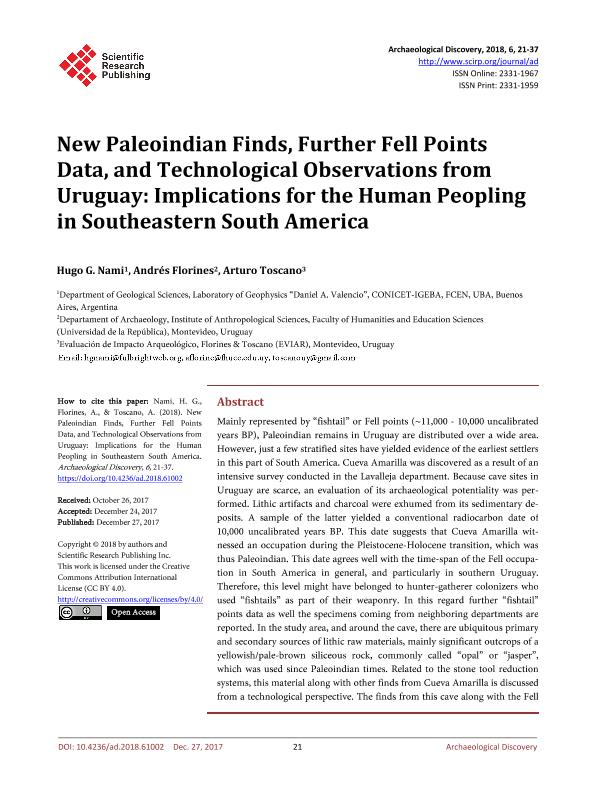Mostrar el registro sencillo del ítem
dc.contributor.author
Nami, Hugo Gabriel

dc.contributor.author
Florines, Andrés
dc.contributor.author
Toscano, Arturo
dc.date.available
2019-10-30T19:07:08Z
dc.date.issued
2018-01
dc.identifier.citation
Nami, Hugo Gabriel; Florines, Andrés; Toscano, Arturo; New Paleoindian Finds, Further Fell Points Data, and Technological Observations from Uruguay: Implications for the Human Peopling in Southeastern South America; Scientific Research; Archaeological Discovery; 6; 1; 1-2018; 21-37
dc.identifier.issn
2331-1959
dc.identifier.uri
http://hdl.handle.net/11336/87695
dc.description.abstract
Mainly represented by “fishtail” or Fell points (~11,000 - 10,000 uncalibrated years BP), Paleoindian remains in Uruguay are distributed over a wide area. However, just a few stratified sites have yielded evidence of the earliest settlers in this part of South America. Cueva Amarilla was discovered as a result of an intensive survey conducted in the Lavalleja department. Because cave sites in Uruguay are scarce, an evaluation of its archaeological potentiality was performed. Lithic artifacts and charcoal were exhumed from its sedimentary deposits. A sample of the latter yielded a conventional radiocarbon date of 10,000 uncalibrated years BP. This date suggests that Cueva Amarilla witnessed an occupation during the Pleistocene-Holocene transition, which was thus Paleoindian. This date agrees well with the time-span of the Fell occupation in South America in general, and particularly in southern Uruguay. Therefore, this level might have belonged to hunter-gatherer colonizers who used “fishtails” as part of their weaponry. In this regard further “fishtail” points data as well the specimens coming from neighboring departments are reported. In the study area, and around the cave, there are ubiquitous primary and secondary sources of lithic raw materials, mainly significant outcrops of a yellowish/pale-brown siliceous rock, commonly called “opal” or “jasper”, which was used since Paleoindian times. Related to the stone tool reduction systems, this material along with other finds from Cueva Amarilla is discussed from a technological perspective. The finds from this cave along with the Fell point finds from the region, are discussed within the framework of the colonization process of South America.
dc.format
application/pdf
dc.language.iso
eng
dc.publisher
Scientific Research
dc.rights
info:eu-repo/semantics/openAccess
dc.rights.uri
https://creativecommons.org/licenses/by-nc-sa/2.5/ar/
dc.subject
PALEOINDIAN
dc.subject
LITHIC TECHNOLOGY
dc.subject
FELL POINTS
dc.subject
SOUTH AMERICA
dc.subject.classification
Arqueología

dc.subject.classification
Historia y Arqueología

dc.subject.classification
HUMANIDADES

dc.title
New Paleoindian Finds, Further Fell Points Data, and Technological Observations from Uruguay: Implications for the Human Peopling in Southeastern South America
dc.type
info:eu-repo/semantics/article
dc.type
info:ar-repo/semantics/artículo
dc.type
info:eu-repo/semantics/publishedVersion
dc.date.updated
2019-10-15T15:20:12Z
dc.identifier.eissn
2331-1967
dc.journal.volume
6
dc.journal.number
1
dc.journal.pagination
21-37
dc.journal.pais
Estados Unidos

dc.description.fil
Fil: Nami, Hugo Gabriel. Consejo Nacional de Investigaciones Científicas y Técnicas. Oficina de Coordinación Administrativa Ciudad Universitaria. Instituto de Geociencias Básicas, Aplicadas y Ambientales de Buenos Aires. Universidad de Buenos Aires. Facultad de Ciencias Exactas y Naturales. Instituto de Geociencias Básicas, Aplicadas y Ambientales de Buenos Aires; Argentina
dc.description.fil
Fil: Florines, Andrés. Universidad de la República; Uruguay
dc.description.fil
Fil: Toscano, Arturo. Evaluación de Impacto Arqueológico; Uruguay
dc.journal.title
Archaeological Discovery
dc.relation.alternativeid
info:eu-repo/semantics/altIdentifier/url/https://www.scirp.org/journal/paperinformation.aspx?paperid=81351
dc.relation.alternativeid
info:eu-repo/semantics/altIdentifier/doi/http://dx.doi.org/10.4236/ad.2018.61002
Archivos asociados
